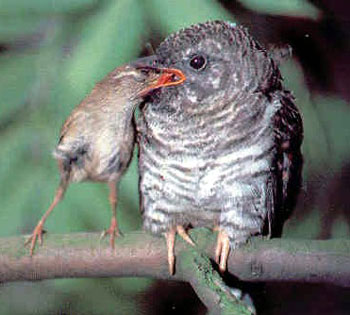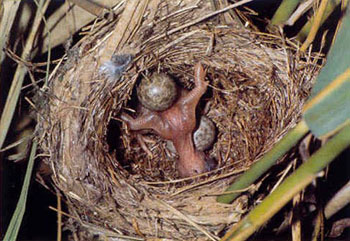Cuckoos and Cuckoldry
Today, our guest, classicist Richard Armstrong goes cuckoo over brood parasites. The University of Houston presents this series about the machines that make our civilization run, and the people whose ingenuity created them.
Few birds have inspired as much folklore as the Common Cuckoo. The cuckoo's distinctive cry [sound] has been the harbinger of spring for centuries in Western Europe. It arrives there in early spring after its yearly migration to East Africa. The adults leave Europe by July, so the birds' brief appearance is very noticeable. The Greek poet Hesiod talked about the time of year,
when the cuckoo first cuckoos in the leaves of the oak
and brings joy to mortals on the boundless earth.
But the cuckoo has also brought confusion to mortals, with its disturbing behavior. For the Common Cuckoo is a brood parasite. This is a bird that lays its eggs in the the nest of another species, leaving the foster parents to raise its young. Since maternal instinct sounds so natural, the cuckoo's shocking actions cried out for explanation.
Aristotle thought the cuckoo should be praised for its resourcefulness. The cuckoo, he reasoned, is cold by nature. That means it's less fertile and it's also cowardly. In Aristotle's physiology, heat is associated with aggressiveness and fertility. His cuckoo thus cannot incubate or defend its own few eggs, and so it wisely resorts to slipping them into the nest of a surrogate mother.
The idea that the cuckoo thus "adulterates" the nest of another led to a connection between cuckoos and cuckoldry. Indeed, the word cuckold is derived from cuckoo. A song in Shakespeare describes spring as the time when,
The cuckoo then on every tree
Mocks married men, for thus he sings: Cuckoo!
These associations even spawned the idea that the cuckoo chick is the hybrid offspring of the foster mother and the philandering male cuckoo. But in truth, the cuckoo hen is the sly one, for she parasitizes the same species that raised her. In a mere ten seconds, she swoops down and lays an egg very similar to her host's, and flies off with one of the host's eggs in her bill.
 The fate of the foster mother's other nestlings lingered as a question. The most grisly account comes from Rome's great naturalist. Pliny the Elder thought the young cuckoo greedily snatches food from its nest-mates, and the foster mother comes to admire the larger bird as it grows in size and strength. Eventually, Pliny claimed, the foster mother will let the cuckoo devour her own puny offspring, while she herself becomes the cuckoo's parting meal.
The fate of the foster mother's other nestlings lingered as a question. The most grisly account comes from Rome's great naturalist. Pliny the Elder thought the young cuckoo greedily snatches food from its nest-mates, and the foster mother comes to admire the larger bird as it grows in size and strength. Eventually, Pliny claimed, the foster mother will let the cuckoo devour her own puny offspring, while she herself becomes the cuckoo's parting meal.
 The truth is rather different, but no less troubling. Edward Jenner in the 18th century discovered the cuckoo chick instinctively ejects the eggs of its foster siblings. This seemed improbable to many, but it's been confirmed by photographic evidence, in which we can plainly see the tiny hatchling wickedly hoisting an egg on its back and tossing it over the side. The chick then lives like a king as an only child; but all is not easy for the murderous brat.
The truth is rather different, but no less troubling. Edward Jenner in the 18th century discovered the cuckoo chick instinctively ejects the eggs of its foster siblings. This seemed improbable to many, but it's been confirmed by photographic evidence, in which we can plainly see the tiny hatchling wickedly hoisting an egg on its back and tossing it over the side. The chick then lives like a king as an only child; but all is not easy for the murderous brat.
By July its relatives have disappeared, and in September, it must find its own way to East Africa with nothing but raw instinct to guide it. And this mystery remains: Just how do young cuckoos find their deadbeat parents and their friends all by themselves? Perhaps the cuckoo is not so cowardly after all!
I'm Richard Armstrong, at the University of Houston, where we're interested in the way inventive minds work.
Richard H. Armstrong studied Romance and Classical Philology at the Univ. of Chicago (BA 1986), and Classical and Medieval literature at Yale Univ. (M. Phil. 1990, PhD. 1993). He is currently Assc. Prof. of Classical Studies at the UH, and a Fellow in the Honors College. He, his wife Dawn, and four children live in Houston, where he is an avid bird watcher. His latest book is A Compulsion for Antiquity: Freud and the Ancient World. (Cornell Univ. Press, 2006).
Edward A. Armstrong [no relation to me!], The Folklore of Birds.(London: Collins, 1958), Chapter 12 relates a wealth of information on folk beliefs and rituals surrounding the Common Cuckoo (Cuculus canorus).
N. B. Davies, Cuckoos, Cowbirds, and Other Cheats. (London: T & AD Poyser, 2000) is an extensive study of brood parasitism and a very good example of well written natural science.
John Pollard, Birds in Greek Life and Myth. (London: Thames and Hudson, 1977): pp. 43-45, discusses specifically ancient Greek authors on the cuckoo.
Ancient texts:
Aristotle, The Generation of Animals. 3.1.750a13-16, trans. by A. L. Peck (Cambridge: Harvard UP, 1953), p. 269.
Pliny the Elder, Natural History. 10.11.25-27, trans. by H. Rackham (Cambridge: Harvard UP, 1967), Vol. 3, pp. 309-311.
Aelian, On the Characteristics of Animals. 3.30, trans. by A. F. Scholfield (Cambridge: Harvard UP), Vol. 1, pg. 193.
Thanks to the University of Glasgow's Theoretical Ecology Group for the remarkable photos above. The first shows a small reed warbler feeding a large cuckoo chick. The second shows a recently hatched cuckoo chick ejecting an egg of its foster sibling.
The Edward Jenner mentioned in the text above is the same Jenner who is famous for developing smallpox vaccination in England (although it had previously been promoted by Cotton Mather in the Colonies, and Mather had, in turn learned of it from his slaves.)